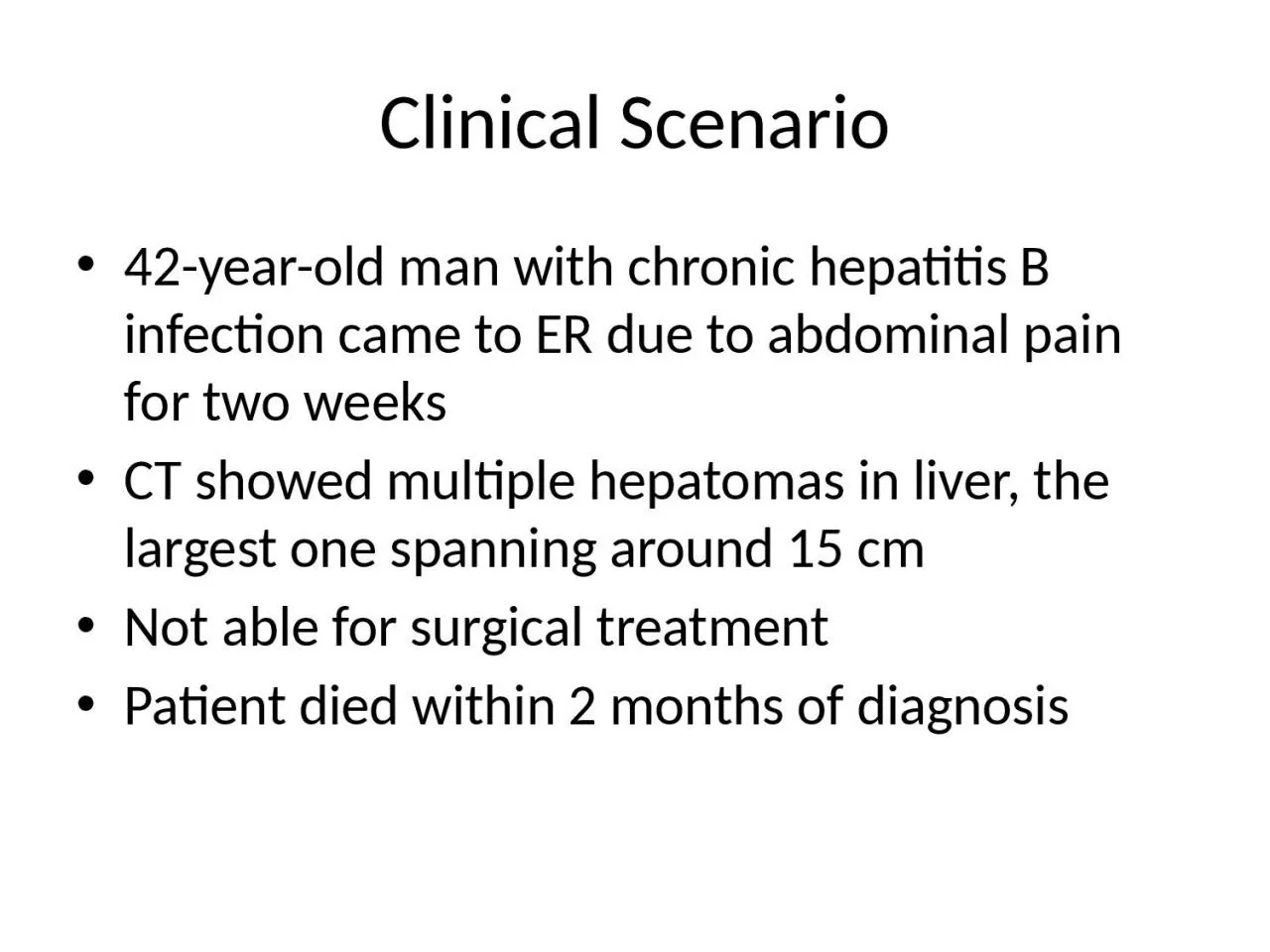

CT showed multiple hepatomas in liver the largest one spanning around 15 cm Not able for surgical treatment Patient died within 2 months of diagnosis Clinical Scenario 56yearold man with chronic hepatitis B ID: 1033526
Download Presentation The PPT/PDF document "Clinical Scenario 42-year-old man with c..." is the property of its rightful owner. Permission is granted to download and print the materials on this web site for personal, non-commercial use only, and to display it on your personal computer provided you do not modify the materials and that you retain all copyright notices contained in the materials. By downloading content from our website, you accept the terms of this agreement.
1. Clinical Scenario42-year-old man with chronic hepatitis B infection came to ER due to abdominal pain for two weeksCT showed multiple hepatomas in liver, the largest one spanning around 15 cmNot able for surgical treatmentPatient died within 2 months of diagnosis
2. Clinical Scenario56-year-old man with chronic hepatitis B Last abdominal echo was three years ago and no abnormal tumor was seen at thenCame to OPD because of fatigue, poor appetite and jaundice recentlyCT showed a huge hepatoma (20cm) with portal vein thrombosisPatients died 6 months after diagnosis
3. Clinical Scenario 65-year-old woman, with hepatitis history, but does not know whether it’s B or CRegular having some blood test at local medical clinical for “ liver function testing”Referred to OPD due to hepatoma noticed in echoMultiple metastatic tumors in lung and boneDied 8 months after diagnosis
4. QuestionsIs HCC so hard to treatYesCan HCC ever be curedYesHow to improve cure rate?Prevention, surveillance, and early detection
5. HBVHCVEtOHLipidToxinFeChronic hepatitisLiver cirrhosisHCC20% in 10 years
6. Prevention of HCC - HBVVaccinationSince 1985, new-born children in Taiwan would all get HBV vaccinationThe incidence of HCC decreased 69% when comparing those who received vaccine with those who did not receive vaccinationJ Natl Cancer Inst 2009; 101: 1348
7. Prevention of HCC- HBVPrevent transmission of HBVScreening for blood donationsPassive HBV immunization for patients exposed to HBV (eg: needle stick)
8. Prevention of HCC - HBVActive treatment for HBV carriersEarly treatment decreases the risk of developing HCC for HBV carriersHBeAg (+)HBV with liver cirrhosisInterferonNeucleotide analogue
9. Both Antiviral Treatments Are GoodAliment Pharmacol Ther 2008; 28: 1067
10. Prevention of HCC - HCVPrevent HCV infection and cirrhosisHCV is more prevalent in Yun-Lin county than another other parts of TaiwanPoor health-related procedure and equipment hygieneDrug abusers, needle users
11. Prevention of HCC - HCVScreening for high risk populationClose follow-up of HCV activity and early treatment of HCV when possible
12. Prevention of HCC - CirrhosisAlcoholNon-alcoholic steatohepatitis (NASH)MetalFe (hemochromatosis)Copper (Wilson’s disease)Toxin - AflatoxinAutoimmunePrimary biliary cirrhosisPrimary sclerosing cholangitis
13. Prevention of HCC – Control DMTaiwan’s DataDM correlated with HCCHR 1.73 (95% CI 1.47 – 2.03)Some drugs related to decreased risk of HCCMetformin HR 0.49 (95% CI 0.37 -0.66)Thiazolidinediones HR 0.56 ( 95% CI 0.37 -0.84)Am J Gastroenterol 2012; 107: 46
14. HBVHCVEtOHLipidToxinFeChronic hepatitisLiver cirrhosisHCCSurveillanceSurveillance
15. Cost-effectiveness of SurveillanceUptodate HCC surveillance recommendations
16. Incidence of HCC in HBV CarriersCaucasian0.2%Asian0.4% -0.6%Start to exceed 0.2% since age of 40 in menAfricanHCC at an earlier age
17. Risk of HCC with A Family HistoryA Taiwan studyThe risk of HCC increases for patients with HBV with a family historyFor men, if one relative with HCCRelative risk 2.09 ( 95% CI 1.21 – 3.62)For men, If two or more relatives diagnosed with HCCRelative risk 5.55 (95% CI 2.02 – 15.26)J Natl Cancer Inst 2000; 92: 1159
18. Surveillance for HBV CarriersAsian men over the age of 40 yearsAsian women over the age of 50 yearsPatients with HBV and cirrhosisAfricans and North American blacks Patients with a family history of HCCFor HBV carrier who have treated with anti-viral therapy AASLD guideline
19. HCC Risk Nomogram for HBV PtsJ Clin Oncol 2010; 28: 2437
20. Surveillance for Cirrhosis PatientsHBVEven virus are clearedHCVAlcoholNASHAutoimmuneHeavy meta metabolism
21. Improved Survival for Patients Dx HCC Within Surveillance (Cirrhotic pts, Asia)Hepatology 2000; 31: 330;Eur J Cancer 2010; 46: 744TaiwanHong Kong
22. Surveillance MethodsUltrasonographyAlpha-fetoprotein (AFP)Intensive screeningLipiodol Computed tomography (LICT)
23. Abdominal US6 months standard ( 3 month not better)Time to first noduleHCC incidenceOverall survivalHepatology 2011; 54: 1987No difference
24. Abdominal US + AFPJ Med Screen 1999; 6 : 108
25. Intensive Screening With CTJ Clin Oncol 2005; 23: 8041
26. No Improvement in Earlier DiagnosisJ Clin Oncol 2005; 23: 8041
27. Surveillance for HBV CarriersAsian men over the age of 40 yearsAsian women over the age of 50 yearsPatients with HBV and cirrhosisAfricans and North American blacks Patients with a family history of HCCFor HBV carrier who have treated with anti-viral therapy AASLD guideline
28. Recommended methodAbdominal ultrasonography with or without alpha-fetal protein (AFS) every 6 monthsCT screening is not recommended
29. Evaluation of Nodules on USNodules smaller than 1cm are usually not HCC, but such lesions should be monitored at shorter intervals (eg 3 months), until proven stable or disappearNodules larger than 1 cm should be evaluated by CT (triphasic) or MRI, if still not typical , may consider biopsyA negative biopsy doesn’t excluded HCC. Keep monitoring every 3 to 6 months is suggested
30. Take Home MessagePrevention from HCC related risk factors is importantSurveillance is suggested in HBV infected patients (selected criteria) and all patients who have liver cirrhosisAbdominal ultrasound with or without AFP is every 6 months is currently recommended surveillance method